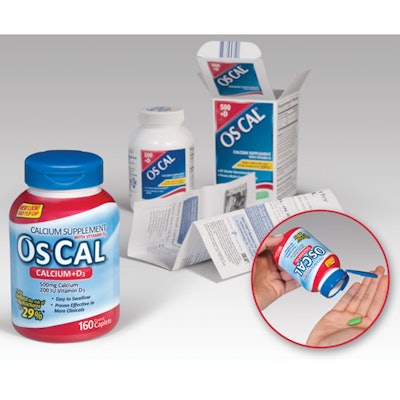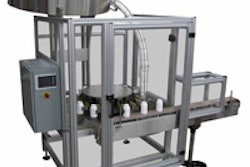Proving once again that when it comes to sustainability, less can be more, a new package design for GlaxoSmithKline Consumer Healthcare’s Os-Cal calcium supplement in four varieties manages to better market the brand’s advantages while eliminating several significant components of excess packaging. In late August, GSK began the rollout of its 150-, 250-, and 400-cc supplement bottles in a bold, full-body shrink-sleeve label, leaving behind a secondary carton and insert with outdated graphics.
“GSK is fully committed to having the right values and fundamentals in place to drive sustainability,” says Jeff Murray, Os-Cal brand manager. “This packaging change hits on two of the main objectives: to reduce the overall environmental impacts of our packaging, and to reduce energy consumption. The redesign also provided us with an opportunity to update the look and feel of Os-Cal, to provide a greater voice to the consumer as they shop in the supplement aisle.”
Existing packaging for the nearly 60- year-old Os-Cal brand consisted of a stock high-density polyethylene bottle from Pretium Packaging, decorated with a wraparound pressure-sensitive label and capped with a continuous-threaded screw cap. The secondary carton and insert provided comprehensive product information. The new design retains the stock bottle only, replacing the p-s label with a full-body polystyrene label from CCL Label and the CT closure with an easy-open flip-top cap.
On an annual basis, the new package design is said to save approximately 208 tons of paper, or 1,440 trees, eliminate nearly 330,000 lb of CO2 emissions (the equivalent of removing 30 cars from the road), and conserve about 2,052 million BTUs, or the energy used by 23 U.S. homes.
Eliminating the carton though required that GSK fully utilize the bottle’s space for branding and data—hence the full-body label. “As we moved from the carton to the bottle, we lost some of the brand blocking at shelf,” explains Murray. “So we wanted to make sure that this look was really going to catch the consumer’s eye and differentiate between our four variants.”
Several Os-Cal brand advantages are highlighted in the new label, designed by Schawk!, including its use of Vitamin D—two of the variants offer more of the vitamin than any other leading calcium supplement—and its claim of 29% fewer hip fractures through use of the product. Distinct color-coding differentiates the four product varieties, for easy identification by the consumer.
In pre-production tests, consumers preferred the new package design 15:1, and early launch results show a preference by retailers, as well. “The response has been great,” says Murray. “Retailers certainly have been receptive to the environmental benefits and to the new package design. We have actually been able to leverage this project for incremental distribution with several retailers, so this is great news for us.”
Os-Cal is priced from $10 to $20, depending on product size, and can be found in the supplement aisle in grocery, mass merchandise, and drugstores.



























